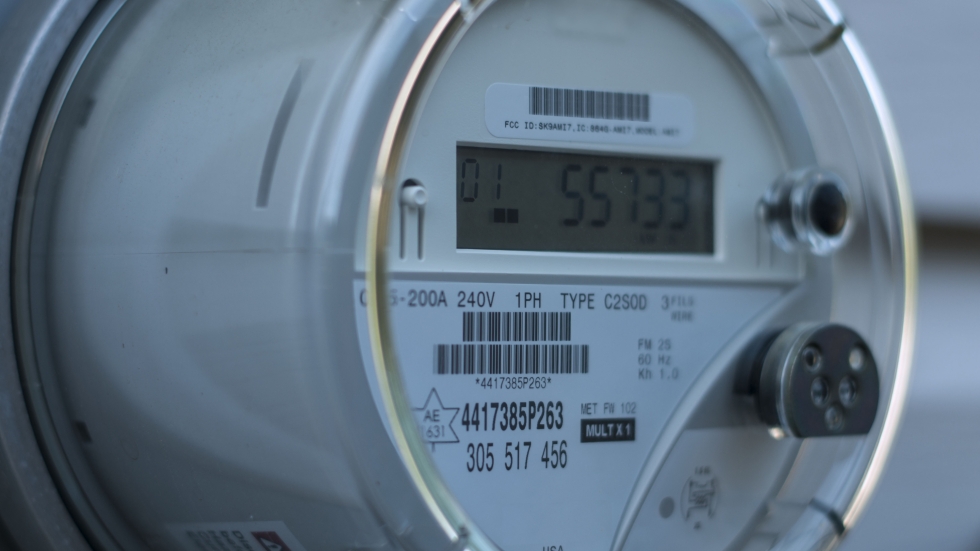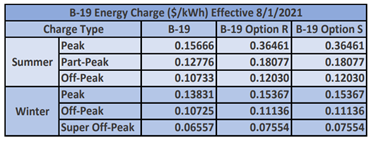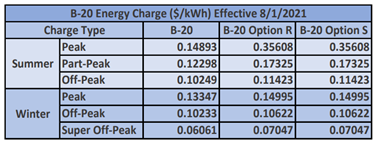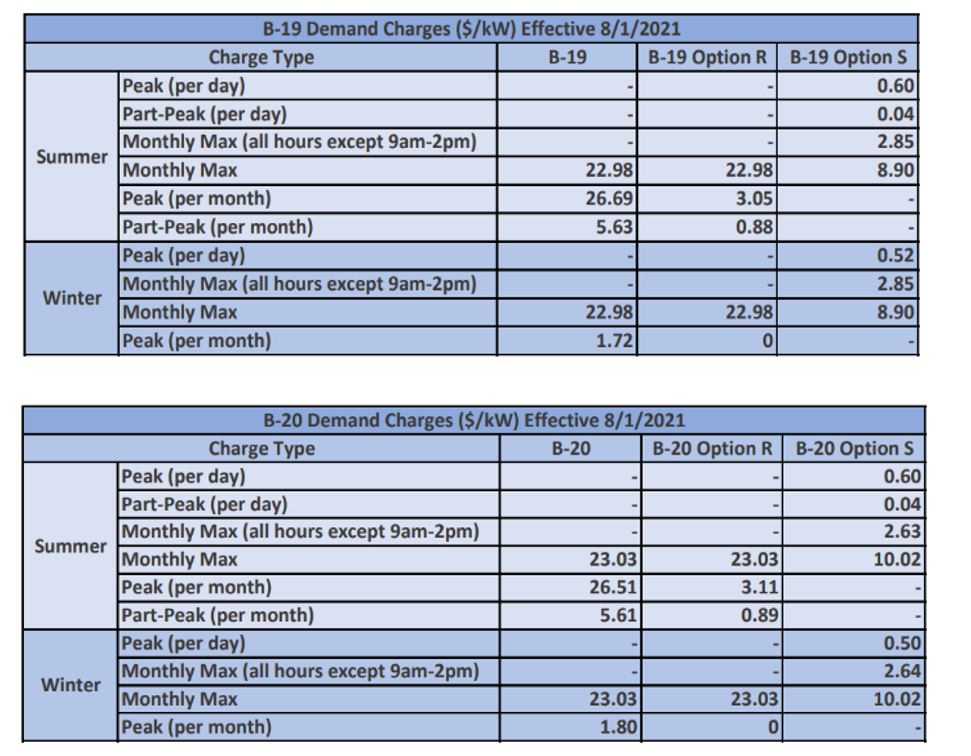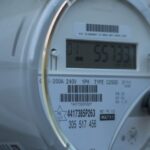Pacific Gas & Electric (PG&E) was the first utility in the state of California, and to the best of our knowledge the first utility in the country, to release an energy storage-friendly rate tariff option that featured daily demand charges, which bill based on $/kilowatt/day. The pioneering Option S rate, “S” standing for “storage-friendly”, was specifically designed to reduce customers’ exposure to high demand charges associated with infrequent periods of elevated load. The idea is to incentivize customers with a behind-the-meter energy storage system (ESS) to shave peak loads throughout the entire month, to capture demand charge reduction savings more effectively.
Background
In November of 2019, PG&E’s new suite of “B” rates were made available to existing non-residential customers on a voluntary opt-in basis. We summarized PG&E’s B rates in a previous blog. These rates were a result of PG&E’s 2017-2019 General Rate Case (GRC) and included several significant changes. The most notable change being the shift in the “on-peak” time-of-use (TOU) period from noon-6 pm to 4-9 pm. Although voluntary to existing PG&E customers when initially rolled out, new customers were automatically placed under the B rates as a default and were unable to elect service under what is now referred to as a “legacy” rate (e.g., A-10 or E-19).
Beginning March of 2021, a mandatory transition to the B rates of all customers not qualified for grandfathering protections began. The protections granted only pertain to the defined TOU time periods of the legacy rates; qualified customers are still subject to other rate changes that occur. The grandfathering period expires for eligible customers in 10-years for permission to operate (PTO) or in 2027. At which point all C&I customers in PG&E will be serviced under a B rate option.
The Option S, daily demand charge rate, was launched as part of the new B rates. The innovative $/kW/day, daily demand charge aspect of the Option S rate design is largely credited to SEIA (Solar Energy Industries Association) who lobbied within Decision 18-08-013 that daily coincident peak demand charges in place of traditional monthly non-coincident demand charges would further enable ESS systems to capture value by discharging during times that would “help reduce grid demand and thereby reduce GHG [greenhouse gas] emissions” all while producing ratepayer benefits by avoiding marginal utility costs. Persuaded by SEIA’s argument, the Commission approved the Option S rate proposal as part of that GRC.
Rate Structure
Option S is currently only offered under medium and large C&I rates: B-19 and B-20. Those qualified for grandfathering under legacy rates E-19 or E-20 but interested in Option S will need to opt onto a B rate, forfeiting their grandfathering rights. Enrollment on Option S is capped at 150 Megawatts (MW), with 50 MW caps for each rate category: B-19 Voluntary, B-19 Mandatory, and B-20. Eligibility requirements include:
- The customer has a storage system with a rated capacity in watts which is at least 10% of the customer’s peak demand over the previous 12 months.
- A minimum of 30 days usage history is required to evaluate whether the battery capacity is at least 10% of the customer’s peak demand. This means that qualifying customers starting a new service agreement at a new location will not be immediately placed under Option S.
Charge Components
The ($/kWh) energy charges of Option S mirror those of the well-known “solar-friendly” Option R rate. For ESS projects this offers a strong price signal for TOU arbitrage opportunities, particularly in the summer season.
For ($/kW) demand charges, the Option S rate has multiple demand charge types, which increases the complexity of understanding and modeling on the rate. The B-19/B-20 standard rate, and Option R versions, feature a monthly on-peak TOU demand charge and part-peak demand charge. This is in addition to a monthly max, non-coincident (NC) demand charge. Meanwhile, Option S includes daily on-peak and part-peak TOU demand charges in addition to a monthly ($/kW/month) max demand charge that is assessed monthly and applied to all hours except 9 am to 2 pm. It also includes a standard max monthly ($/kW/month) NC demand charge.
Option S – Reservation System
To reduce the risk that a project does not secure Option S capacity, which was a concern voiced by SEIA and CALSSA, PG&E implemented a pre-PTO reservation system for Option S. This reservation process launched for new customers on August 24th, 2021. To reserve capacity on the Option S rate, customers must email OptionS@pge.com with the following information:
- Name of Customer of Record for the Service Agreement
- PG&E Interconnection Application ID
- Service Agreement ID that will be served by the storage system
- Selected Rate (B19-V, B19, B20)
- KW capacity you would like to reserve for the project
- Customer-signed PG&E Interconnect Agreement
Reservation requests will be checked for completeness within five business days. Once verified to be complete, eligibility for the rate will be checked and notification of reservation acceptance can be expected within 10 business days. If deemed eligible but sufficient capacity is not available, customers will be offered to be placed on a waitlist. Reserved capacity will be held for 18 months. If the project does not reach PTO within 18 months, two six-month extensions can be requested by emailing OptionS@pge.com prior to the end of the initial 18-month reservation period. The current number of applicants, megawatts enrolled, and remaining capacity can be viewed on PG&E’s Option S capacity tracker page.
To date, there have been very few Option S enrollments, which we believe is largely due to a lack of understanding of the new tariff and the previous inability to precisely model different PV and ESS scenarios. With the reservation system now in place, tools like ETB Developer which can transparently model bill savings and project economics, it will be interesting to watch enrollment activity going forward.
Modeling Option S in ETB Developer
As part of our recent ETB Developer v4 release, users now have the ability to model Option S and any other types of daily demand charge scenarios. Furthermore, the B-19 and B-20 Option S rate tariff options are published and current in our utility rates database. These rates are updated each time PG&E implements a change to their rates. ETB users are encouraged to contact our Data Team at utilityraterequests@energytoolbase.com with any rate-related questions. We also have a team of dedicated Account Managers eager to help users navigate through ESS opportunities and proposals.
In the next blog in our PG&E Option S, Daily Demand Charge Rate series we will explore and unpack how advantageous the Option S rate is for solar and energy storage savings and project economics. Additionally, we are hosting a webinar on Wednesday, September 8th at 11 am PST: How Advantageous is PG&E’s Option S, daily demand charge rate tariff, for Energy Storage Projects?
Links:
